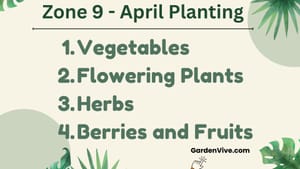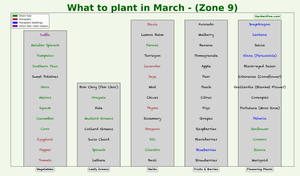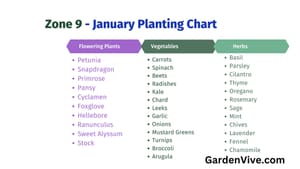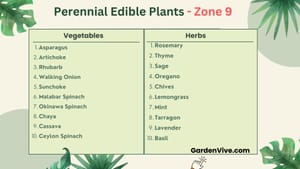
If we want to start planting or sowing seeds in February in Zone 9, we need to consider the weather conditions. January is typically colder than February. This makes it easier to start planting outdoors in February. In this article, you will find February planting charts for Zone 9 (Both indoors and outdoors).
I have checked the weather reports for the last 10 years of USDA Zone 9 and summarized them in this chart so that you can get an idea.
| Location | Average Low Temp (°F) | Average High Temp (°F) |
|---|---|---|
| Los Angeles, CA | 50 | 68 |
| Houston, TX | 54 | 72 |
| Orlando, FL | 57 | 75 |
| Phoenix, AZ | 48 | 72 |
| Tallahassee, FL | 39 | 67 |
| San Antonio, TX | 44 | 68 |
| Fresno, CA | 39 | 63 |
| Las Vegas, NV | 44 | 66 |
| Sacramento, CA | 40 | 62 |
I have only mentioned the popular cities on my list just to give you an idea.
I know Zone 9 in Florida is different from Zone 9 in California. Gardening involves a lot of other factors (for example soil). In my chart, the plants I am adding can be grown well in Zone 9, regardless of which state you're in.
Regular readers of mine already know that I bring planting charts each month. Some of you love to start seeds indoors for warm-season crops. This is why you will find what seeds you can start along with what to plant in February.
Dividing these charts into two major categories:
- What seeds to start indoors
- What to plant outside
Seeds to start indoors in February - Zone 9
I love experiments and I found three types of seeds perform well if started indoors.
- Warm season crops - These should be started indoors as they need warm soil and temperatures. (February is still cold to start these outdoors)
- Plants with long growing seasons.
- Delicate flowers or those needing controlled conditions.
Vegetables
| Plant Name | Planting Method | Transplanting Time | Optimal Germination Temp. (°F) | Germination Time (days) | Variety Suggestions |
|---|---|---|---|---|---|
| Tomatoes | Seed trays or pots | March 15 - April 1 | 70-85 | 5-10 | Roma, Cherry, Beefsteak |
| Peppers | Seed trays or pots | March 15 - April 1 | 70-85 | 7-21 | Bell, Jalapeño, Cayenne |
| Eggplants | Seed trays or pots | March 20 - April 5 | 75-90 | 7-14 | Black Beauty, Fairy Tale |
| Broccoli | Seed trays | March 1 - March 15 | 65-75 | 5-10 | Calabrese, Green Magic |
| Kale | Seed trays | March 1 - March 15 | 65-75 | 5-10 | Lacinato, Red Russian |
| Cabbage | Seed trays | March 1 - March 15 | 65-75 | 5-10 | Golden Acre, Savoy |
| Cauliflower | Seed trays | March 1 - March 15 | 65-75 | 5-10 | Snowball, Cheddar |
| Lettuce | Seed trays | March 1 - March 10 | 60-75 | 7-14 | Butterhead, Romaine |
| Swiss Chard | Seed trays | March 1 - March 15 | 50-85 | 7-14 | Bright Lights, Fordhook Giant |
| Onions (from seeds) | Seed trays | March 15 - March 30 | 65-85 | 7-14 | Walla Walla, Red Burgundy |
| Basil | Seed trays or pots | March 20 - April 5 | 65-75 | 7-14 | Genovese Basil |
| Celery | Seed trays | March 15 - April 1 | 70-75 | 14-21 | Tall Utah, Tango |
| Leeks | Seed trays | March 15 - March 30 | 65-75 | 7-14 | American Flag, King Richard |
You can see there are a lot of winter crops included in my list. You might be wondering if they will survive or not if transplanted in March.
They will perform well as March in Zone 9 marks the transition from winter to spring. (Mild and pleasant weather)
If you are serious about starting the seeds indoors, grow light is essential for these veggies and herbs:
- Tomatoes
- Peppers
- Eggplants
- Swiss Chard (Bright and indirect light will also work)
- Basil
- Celery
- Leeks
The rest of the seeds can do fine without grow lights. Place them near a window where they can get bright light.
Flowering seeds
| Plant Name | Planting Method | Transplanting Time | Optimal Germination Temp. (°F) | Germination Time (days) | Blooming Season |
|---|---|---|---|---|---|
| Marigolds | Seed trays or pots | March 15 - April 1 | 70-75 | 5-10 | Late Spring to Summer |
| Zinnias | Seed trays or pots | March 15 - April 1 | 70-75 | 5-10 | Summer to Fall |
| Petunias | Seed trays or pots | March 15 - April 1 | 65-75 | 7-14 | Spring to Summer |
| Snapdragons | Seed trays | March 1 - March 15 | 65-75 | 10-14 | Spring to Summer |
| Sweet Peas | Seed trays or pots | March 15 - April 1 | 55-65 | 7-14 | Spring to Early Summer |
| Lavender | Seed trays or pots | March 15 - April 1 | 65-70 | 14-21 | Late Spring to Summer |
| Chrysanthemums (Mums) | Seed trays | March 1 - March 15 | 65-75 | 7-14 | Fall |
| Begonias | Seed trays or pots | March 15 - April 1 | 70-75 | 10-15 | Summer to Fall |
| Cosmos | Seed trays or pots | March 15 - April 1 | 70-75 | 7-14 | Summer to Fall |
| Geraniums | Seed trays or pots | March 15 - April 1 | 65-75 | 10-14 | Spring to Fall |
| Hibiscus | Seed trays or pots | March 15 - April 1 | 70-75 | 7-14 | Summer to Fall |
| Gerbera Daisy | Seed trays or pots | March 15 - April 1 | 70-75 | 7-14 | Spring to Summer |
Note: As temp. rise, you may witness aphids on flowering plants. I have faced this with my Chrysanthemums. Hope this guide will help you: Get rid of Aphids on Mums
What to plant outdoors in February in Zone 9
The plants in the below charts can be planted outdoors. You can start from seeds as well.
If you are lazy, it's better to sow the seeds in such a way that you do not have to transplant them in a later phase.
The spacing I have mentioned is the minimum distance between two adjacent plants you should maintain.
Vegetables
| Plant Name | Planting Method | Spacing (inches) | Harvesting Time (days) | Variety Suggestions |
|---|---|---|---|---|
| Spinach | Direct sow | 6-8 | 40-50 | Baby's Leaf, Bloomsdale Long Standing |
| Carrots | Direct sow | 2-4 | 70-80 | Nantes, Danvers 126 |
| Lettuce | Direct sow or transplant | 10-12 | 45-55 | Butterhead, Romaine, Iceberg |
| Peas | Direct sow | 2-3 | 60-70 | Snap peas, Snow peas, Shelling peas |
| Onions | Set or transplant | 4-6 | 100-175 | Texas Super Sweet, Walla Walla |
| Garlic | Plant cloves | 4-6 | 180-240 | Softneck, Hardneck |
| Kale | Direct sow or transplant | 12-18 | 50-70 | Lacinato, Curly, Siberian |
| Broccoli | Transplant | 12-18 | 60-90 | Calabrese, Waltham 29 |
| Cauliflower | Transplant | 12-18 | 60-100 | Snowball, Cheddar, Early Snowball |
| Beets | Direct sow | 3-4 | 50-60 | Detroit Dark Red, Chioggia |
| Swiss Chard | Direct sow or transplant | 6-8 | 50-60 | Bright Lights, Fordhook Giant |
| Cabbage | Transplant | 12-18 | 70-100 | Green Glaze, Savoy, Red Express |
Flowering Plants
| Plant Name | Planting Method | Spacing (inches) | Blooming Season | Perennial or Annual |
|---|---|---|---|---|
| Primroses | Direct sow or transplant | 6-8 | Spring, early summer | Perennial |
| Snapdragons | Direct sow or transplant | 8-12 | Spring to fall | Annual |
| Pansies | Direct sow or transplant | 6-8 | Spring, fall | Annual |
| Sweet Peas | Direct sow | 4-6 | Spring to early summer | Annual |
| California Poppies | Direct sow | 6-8 | Spring to early summer | Annual |
| Shasta Daisies | Direct sow or transplant | 12-18 | Late spring to summer | Perennial |
| Fuchsias | Transplant | 12-18 | Summer to fall | Perennial |
| Lobelia | Direct sow or transplant | 8-12 | Late spring to summer | Annual |
| Marigolds | Direct sow or transplant | 8-12 | Late spring to fall | Annual |
| Petunias | Direct sow or transplant | 10-12 | Spring to fall | Annual |
| Sweet William | Direct sow or transplant | 6-8 | Spring to early summer | Perennial |
Generally, flowering plants need a lot of direct sunlight but Primroses will do better if planted in partial shade.
Berries
| Berry Name | Planting Method | Spacing (inches) | Perennial or Annual | Variety Suggestions |
|---|---|---|---|---|
| Strawberries | Transplant or bare root | 12-18 | Perennial | Chandler, Sequoia, Albion |
| Blueberries | Transplant | 18-24 | Perennial | Bluecrop, Legacy, Sunshine Blue |
| Raspberries | Transplant or bare root | 18-24 | Perennial | Heritage, Fall Gold, Red Latham |
| Blackberries | Transplant or bare root | 24-36 | Perennial | Boysenberry, Marionberry, Triple Crown |
| Goji Berries | Transplant | 36-48 | Perennial | Sweet Lifeberry, Crimson Star |
| Currants | Transplant or bare root | 18-24 | Perennial | Red Lake, White Imperial, Blackdown |
| Mulberries | Transplant | 24-36 | Perennial | Illinois Everbearing, Morus Nigra |
| Huckleberries | Transplant | 18-24 | Perennial | Blue, Red |
| Boysenberries | Transplant or bare root | 24-36 | Perennial | Thornless Boysenberry |
The varieties in my chart will do the best if planted in February. This is not necessary to go for the recommended varieties.
If you want full-year planting charts for Zone 9, I have a separate article: Zone 9 Planting Calendar.
Want printable PDF files of planting charts? Subscribe to this site and become a premium member of this site. I will send you the files via e-mail.






